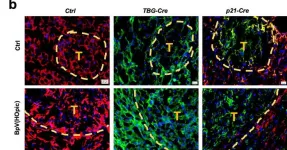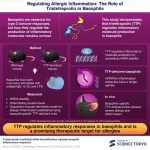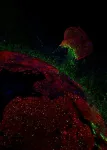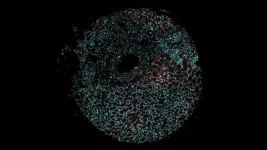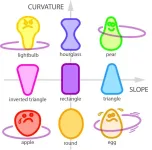(Press-News.org) Scientists at University of California San Diego School of Medicine have shed new light on the development of liver cancer, the sixth most frequently diagnosed cancer and fourth leading cause of cancer deaths worldwide. The study, published in Nature, reveals a complex interplay between cellular metabolism and DNA damage that drives the progression of fatty liver disease to cancer. The findings suggest new paths forward for preventing and treating liver cancer and have significant implications on our understanding of cancer’s origin and the effects of diet on our DNA.
The incidence of the most common form of liver cancer, hepatocellular carcinoma (HCC), has grown by 25-30% in the past two decades, with much of the growth attributed to the dramatic rise in fatty liver disease, which currently affects 25% of adult Americans. About 20% of individuals with fatty liver disease have a severe form of the disease, called metabolic dysfunction-associated steatohepatitis (MASH), that greatly increases the risk of HCC. However, how MASH transitions to liver cancer is not well understood.
“Going from fatty liver disease to MASH to liver cancer is a very common scenario, and the consequences can be deadly,” said Michael Karin, Ph.D., Distinguished Professor in the Department of Pharmacology at UC San Diego School of Medicine. “When you have MASH, you either end up destroying your liver and then you need a new liver, or you progress to frequently fatal liver cancer, but we still don’t understand what’s happening at the subcellular level during this process.”
The researchers used a combination of mouse models and human tissue specimens and databases to demonstrate that MASH-inducing diets, which are rich in fat and sugar, cause DNA damage in liver cells that causes them to go into senescence, a state in which cells are still alive and metabolically active but can no longer divide. Senescence is a normal response to a variety of cellular stressors. In a perfect world, senescence gives the body time to repair damage or eliminate the damaged cells before they’re allowed to proliferate more widely and become cancerous.
However, as the researchers discovered, this isn’t what happens in liver cells, also known as hepatocytes. In hepatocytes, some damaged cells survive this process.
These cells are, according to Karin, “like ticking time bombs that could start proliferating again at any point and ultimately become cancerous.”
“Comprehensive genomic analyses of tumor DNA indicate that they originate from liver cells damaged by MASH, emphasizing a direct link between diet-induced DNA damage and the development of cancer,” added study co-author Ludmil Alexandrov, Ph.D., associate professor of cellular and molecular medicine and bioengineering at UC San Diego and member of UC San Diego Moores Cancer Center.
The findings suggest that developing new drugs to prevent or reverse DNA damage could be a promising therapeutic approach for preventing liver cancer, particularly in people with MASH.
“There are a few possibilities for how this could be leveraged into a future treatment, but it will take more time and research to explore these ideas,” said Karin. “One hypothesis is that a high-fat diet could lead to an imbalance in the raw materials our cells use to build and repair DNA, and that we could use drugs or nutri-chemicals to correct these imbalances. Another idea is developing new antioxidants, much more efficient and specific than the ones we have now, and using those could help block or reverse the cellular stress that causes DNA damage in the first place.”
In addition to opening these new avenues of treatment for liver cancer, the study also offers new insight into the relationship between aging and cancer.
“We know that aging increases the risk of virtually all cancers and that aging is associated with cellular senescence, but this introduces a paradox since senescence is supposed to guard against cancer,” said Karin. “This study helps reveal the underlying molecular biology that allows cells to re-enter the cell cycle after undergoing senescence, and we believe that similar mechanisms could be acting in a wide range of cancers.”
The findings also help directly quantify the detrimental effects of poor diet on cellular metabolism which, according to Karin, could be used to help guide public health messaging related to fatty liver disease.
“A poor, fast-food diet can be as dangerous as cigarette smoking in the long run,” said Karin. “People need to understand that bad diets do far more than just alter a person’s cosmetic appearance. They can fundamentally change how our cells function, right down to their DNA.”
Co-authors on the study include Li Gu, Yahui Zhu, Shuvro Nandi, Maiya Lee, Kosuke Watari, Breanna Bareng, Masafumi Ohira, Yuxiao Liu, Sadatsugu Sakane, Debanjan Dhar, Souradipta Ganguly, Mojgan Hosseini, Tatiana Kisseleva and Ludmil Alexandrov at UC San Diego School of Medicine (Alexandrov is also a professor at the UC San Diego Jacobs School of Engineering), Rodrigo Carlessi, The Liver Cancer Collaborative and Janina Tirnitz-Parker at Curtin Health Innovation Research Institute, Consuelo Sauceda and David Gonzalez at UC San Diego Skaggs School of Pharmacy and Pharmaceutical Sciences, Marcos Teneche and Peter Adams at Sanford Burnham Prebys and M. Celeste Simon at Abramson Family Cancer Research Institute. After completing their training at UC San Diego, Li Gu and Yahui Zhu finished one of the key experiments at their lab in West China Hospital at Chengdu, PRC.
This study was funded, in part, by the National Institutes of Health (grants R01DK120714, R01DK133448, R01CA234128, R01CA281784, P01CA281819, R01DK133448, R35CA220483, DK099205, (R01ES030993, R01ES032547, R01CA269919).
# # #
END
A “ticking time bomb” for liver cancer
Liver cells shut themselves down to guard against cancer; however, it doesn’t work very well
2025-01-02
ELSE PRESS RELEASES FROM THIS DATE:
Targeting tristetraprolin in basophils: A breakthrough in allergic inflammation treatment
2025-01-02
Inflammation is a crucial part of the body’s defense mechanism, playing a key role in fighting infections and repairing tissue damage. Basophils, a type of immune cell that makes up less than 1% of white blood cells, have recently emerged as critical players in triggering allergic responses by releasing pro-inflammatory cytokines like IL-4. Despite the established role of basophils in inflammation, the molecular mechanisms controlling their cytokine production have remained unclear.
To address this gap, a group of researchers from Institute of Science Tokyo, led by Professor Kensuke Miyake, conducted a study to explore the role of tristetraprolin ...
Bringing the magic of playing music to the virtual world
2025-01-02
Researchers are aiming to bring the magic of playing music in person to the virtual world.
The Joint Active Music Sessions (JAMS) platform, created at the University of Birmingham, uses avatars created by individual musicians and shared with fellow musicians to create virtual concerts, practice sessions, or enhance music teaching.
Dr Massimiliano (Max) Di Luca from the University of Birmingham explains: “A musician records themselves and sends the video to another musician. The software creates a responsive avatar ...
Psychedelic drug therapy may address mental health concerns in people with cancer and addiction
2025-01-02
One or two doses of psilocybin, a compound found in psychedelic mushrooms, may improve the mental health of cancer patients when accompanied by psychotherapy, a new report suggests. A second new study found that treatment with psilocybin resulted in lasting, positive personality changes in patients with alcohol use disorder.
The first report’s findings were published online Oct. 7 in the journal Nature Mental Health, and the second published online Jan. 1 in a special edition of The American Journal of Psychiatry focused on psilocybin research.
In the first study, a team of experts at NYU Langone Health found that psilocybin accompanied by psychotherapy significantly reduced anxiety, ...
Too many men or too few women?—new study finds how the gender gap is framed affects perceptions of it
2025-01-02
To many, Vice President Kamala Harris’s loss in the 2024 presidential election was a sobering reminder of a larger and continuous gender gap across leadership positions in not only government, but also in business, higher education, and the military. A majority of Americans recognize the inadequacy of female representation in leadership, and the news media often portray women’s underrepresentation in these roles—but it nonetheless persists.
Recognizing that news coverage may have influence in forming attitudes and in driving ...
AI can improve ovarian cancer diagnoses
2025-01-02
A new international study led by researchers at Karolinska Institutet in Sweden shows that AI-based models can outperform human experts at identifying ovarian cancer in ultrasound images. The study is published in Nature Medicine.
“Ovarian tumours are common and are often detected by chance,” says Professor Elisabeth Epstein at the Department of Clinical Science and Education, Södersjukhuset (Stockholm South General Hospital), at Karolinska Institutet and senior consultant at the hospital’s Department of Obstetrics and Gynecology. “There is a serious shortage of ultrasound experts in many parts of the world, which has ...
Zebrafish protein unlocks dormant genes for heart repair
2025-01-02
Researchers from the Bakkers group at the Hubrecht Institute have successfully repaired damaged mouse hearts using a protein from zebrafish. They discovered that the protein Hmga1 plays a key role in heart regeneration in zebrafish. In mice, this protein was able to restore the heart by activating dormant repair genes without causing side effects, such as heart enlargement. This study, supported by the Dutch Heart Foundation and Hartekind Foundation, marks an important step toward regenerative therapies to prevent heart failure. The findings were published in Nature Cardiovascular Research on January 2, 2025.
After a heart attack, the human heart loses millions of muscle cells that cannot ...
How good are AI doctors at medical conversations?
2025-01-02
Artificial intelligence tools such as ChatGPT have been touted for their promise to alleviate clinician workload by triaging patients, taking medical histories and even providing preliminary diagnoses.
These tools, known as large-language models, are already being used by patients to make sense of their symptoms and medical tests results.
But while these AI models perform impressively on standardized medical tests, how well do they fare in situations that more closely mimic the real world?
Not that great, according to the findings of a new study led by researchers at Harvard Medical School and Stanford University.
For their analysis, published Jan. 2 in Nature ...
A speckle of hope for cancer patients
2025-01-02
Fighting cancer can seem like a deadly game of chance. While some patients may respond well to certain treatments, others might not be as fortunate. Doctors and scientists have long struggled to explain why. Now, Cold Spring Harbor Laboratory (CSHL) Assistant Professor Katherine Alexander and University of Pennsylvania Professor Shelley Berger have found a possible source of this variability in clear cell renal cell carcinoma (ccRCC)—the most common kidney cancer diagnosed in adults.
Alexander ...
How does a hula hoop master gravity? Mathematicians prove that shape matters
2025-01-02
Hula hooping is so commonplace that we may overlook some interesting questions it raises: “What keeps a hula hoop up against gravity?” and “Are some body types better for hula hooping than others?” A team of mathematicians explored and answered these questions with findings that also point to new ways to better harness energy and improve robotic positioners.
The results are the first to explain the physics and mathematics of hula hooping.
“We were specifically interested in what kinds of body motions and shapes could successfully hold the hoop up and what physical requirements and restrictions are involved,” explains ...
New method to measure 5G radiation from mobile phones and base stations
2025-01-02
A team of researchers from Project GOLIAT has developed and applied a new protocol to measure exposure to mobile phone radiation, in particular from 5G. The researchers measured radiofrequency electromagnetic field (RF-EMF) levels during three different scenarios: when the mobile device is in flight mode (non-user), when the mobile phone is used intensively by either downloading or uploading data. The study demonstrates that e.
The research was conducted in Switzerland, one of the first countries in Europe to roll out 5G networks on a large scale. The results have now been published in Environmental Research and provide relevant data for epidemiological ...
LAST 30 PRESS RELEASES:
Making lighter work of calculating fluid and heat flow
Normalizing blood sugar can halve heart attack risk
Lowering blood sugar cuts heart attack risk in people with prediabetes
Study links genetic variants to risk of blinding eye disease in premature infants
Non-opioid ‘pain sponge’ therapy halts cartilage degeneration and relieves chronic pain
AI can pick up cultural values by mimicking how kids learn
China’s ecological redlines offer fast track to 30 x 30 global conservation goal
Invisible indoor threats: emerging household contaminants and their growing risks to human health
Adding antibody treatment to chemo boosts outcomes for children with rare cancer
Germline pathogenic variants among women without a history of breast cancer
Tanning beds triple melanoma risk, potentially causing broad DNA damage
Unique bond identified as key to viral infection speed
Indoor tanning makes youthful skin much older on a genetic level
Mouse model sheds new light on the causes and potential solutions to human GI problems linked to muscular dystrophy
The Journal of Nuclear Medicine ahead-of-print tip sheet: December 12, 2025
Smarter tools for peering into the microscopic world
Applications open for funding to conduct research in the Kinsey Institute archives
Global measure underestimates the severity of food insecurity
Child survivors of critical illness are missing out on timely follow up care
Risk-based vs annual breast cancer screening / the WISDOM randomized clinical trial
University of Toronto launches Electric Vehicle Innovation Ontario to accelerate advanced EV technologies and build Canada’s innovation advantage
Early relapse predicts poor outcomes in aggressive blood cancer
American College of Lifestyle Medicine applauds two CMS models aligned with lifestyle medicine practice and reimbursement
Clinical trial finds cannabis use not a barrier to quitting nicotine vaping
Supplemental nutrition assistance program policies and food insecurity
Switching immune cells to “night mode” could limit damage after a heart attack, study suggests
URI-based Global RIghts Project report spotlights continued troubling trends in worldwide inhumane treatment
Neutrophils are less aggressive at night, explaining why nighttime heart attacks cause less damage than daytime events
Menopausal hormone therapy may not pose breast cancer risk for women with BRCA mutations
Mobile health tool may improve quality of life for adolescent and young adult breast cancer survivors
[Press-News.org] A “ticking time bomb” for liver cancerLiver cells shut themselves down to guard against cancer; however, it doesn’t work very well
